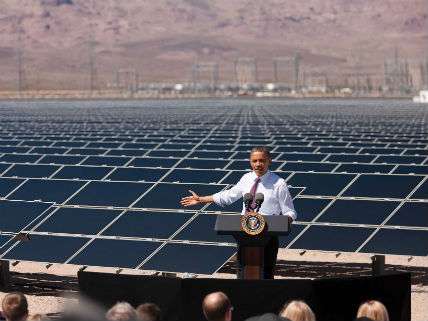Obama: Clean Energy Future Is Irreversible and Will Outlast Trump
Still, it is always good to have some idea of what tradeoffs proposed policies would impose.

President Barack Obama declared that "one of the reasons I ran for this office was to make America a leader in this mission" to address the problem of man-made climate change. He made this claim to a legacy last October when the Paris Agreement on climate change achieved enough signatories to come into effect. Also in his statement hailing the Paris Agreement, Obama noted that "the skeptics said these actions would kill jobs." Yet, he noted that even as U.S. carbon dioxide levels fell to their lowest levels in two decades, more jobs were created.
Now, as a parting shot, President Obama writes an article today, "The irreversible momentum of clean energy," in the journal Science. In his article, President Obama apparently believes that the irreversible momentum of clean energy is all gain and no pain. First, he correctly notes the decoupling over the past 8 years of energy and carbon emissions from economic growth in the U.S. economy. He writes:
Since 2008, the United States has experienced the first sustained period of rapid GHG emissions reductions and simultaneous economic growth on record. Specifically, CO2 emissions from the energy sector fell by 9.5% from 2008 to 2015, while the economy grew by more than 10%. In this same period, the amount of energy consumed per dollar of real gross domestic product (GDP) fell by almost 11%, the amount of CO2 emitted per unit of energy consumed declined by 8%, and CO2 emitted per dollar of GDP declined by 18%.
These figures are from the Economic Report of the President 2017, but comparing them with the preceding 8 years (2000 to 2007) shows a somewhat less rosy picture. For example, according to St. Louis Federal Reserve Bank U.S. real GDP grew by 15 percent between 2000 and 2007 and by 13.5 percent between 2008 and 2015. According to the Energy Information Administration (EIA) energy use per dollar of real GDP declined by around 15 percent between 2000 and 2007 while falling by only 13 percent between 2008 and 2015.
Also according the EIA, CO2 emitted per dollar did fall slightly faster (18 percent) than it did in the preceding period (14 percent between 2000 and 2007); most likely as the result of the recent switch from coal to cheap fracked natural gas and more wind power production to generate electricity. Interestingly, the president's article notes that lower CO2 emissions occurred as power plants switched from coal to natural gas which was "brought about primarily by increased availability of lower-cost gas due to new production techniques." Just couldn't bring himself to mention the f-word, fracking.
Given the economic chaos generated by the financial crisis, it would be hard to draw any firm conclusions from comparing U.S. job creation between 2000-2007 period and the 2008-2015 period. Nevertheless, just as background, the Bureau of Labor Statistics reports that employment rose by 6.5 million in the first period and by 2.2 million in the second period. To be fair, U.S. employment rose from its 2010 nadir by 10.8 million by 2015.
In his Science article, the president cites various studies that suggest in an increase of 4 degrees Celsius by 2100 would lower global GDP by as much as 5 percent below what it would otherwise have been without any man-made warming. To get some idea of what that would mean consider what would happen if current U.S. GDP of $16 trillion were to grow at the 2 percent per year rate experienced during the Obama administration from 2015 until 2100 in the absence of warming. By then U.S. GDP would exceed $86 trillion dollars. If global warming were to lower GDP by 5 percent that would mean that GDP in 2100 would be a little more than $4 trillon dollars lower at $82 trillion.
Now if the U.S. economy were to grow at the historical average of 3 percent per year, GDP in 2100 would stand at $197 trillion and a 5 percent climate change penalty would reduce that to only $187 trillion. That $10 trillion reduction in 2100 is equivalent to lowering the economic growth rate between now and then from 3 percent to 2.93 percent. For comparison, the U.N. has estimated that the additional investment and financial flows needed in 2030 to address climate would have to rise to between 0.3 and 0.5 percent of global GDP.
It is always good to have some idea of what tradeoffs proposed policies would impose.


Show Comments (94)